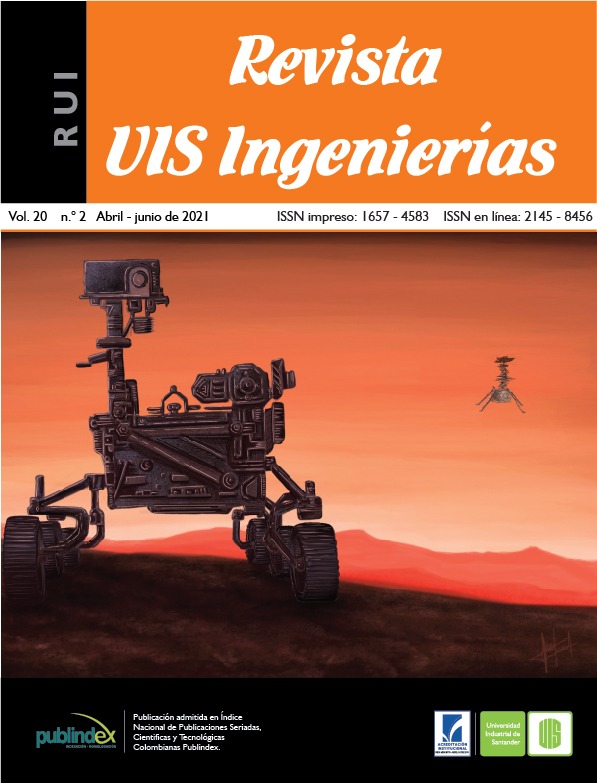Published 2021-01-02
Keywords
- solar energy,
- dehydration,
- energetic analysis,
- thermal performance,
- efficiency
- solar radiation,
- overall drying efficiency ...More
How to Cite
Abstract
The dehydration process allows agricultural products to be handled in post-harvest seasons, managing to preserve them for longer without causing significant changes in the properties of the product. This study focuses on conducting the energetic evaluation of a solar tunnel dryer for fruits by natural convection, which is located in the village of Las Mangas, municipality of Santa Rosa de Cabal, Risaralda, for the drying processes of banana and tomatoes as foods that registers high rates of crop and production in the area. Then, identified in the first place the constructive characteristics of the device, it was continued to effectuate the operational evaluation that consisted in the study of the dryer applying heat transfer concepts to the collector chamber, as well as energy and mass balance to the drying process. Thus, this analysis allowed to quantify the thermal performance about 30%, the efficiency during the dehydration process with averages of 11.2%, 14.6% and 18.3% for the cases analyzed: without load, with banana and tomato respectively and the overall performance of the system, with averages of 30.5%, 33.2% and 41.2% for the same cases respectively. Some recommendations to improve the dehydrator design and its performance are suggested in this work.
Downloads
References
[2] J. Gómez-Ramírez, J. D. Murcia-Murcia, I. Cabeza-Rojas, “La energía solar fotovoltaica en Colombia: potenciales, antecedentes y perspectivas”, trabajo de grado, Universidad Santo Tomás, 2018.
[3] N. N. Potter, H. J. Hotchkiss, Ciencia de los alimentos, 5ta ed. Zaragoza, España: Acribia, 1999.
[4] A.G.M.B. Mustayen, S. Mekhilef, R. Saidur, “Performance study of different solar dryers: A review”, Renewable and Sustainable Energy Reviews, vol. 34, pp. 463-470, 2014, doi: 10.1016/j.rser.2014.03.020
[5] I. López Cerino, E. Chávez García, “Eficacia de secador solar tipo túnel con cacao (Theobroma Cacao L.) en Tabasco”, Revista mexicana de ciencias agrícolas, vol. 9, no. 21, pp. 4395-4405, 2018, doi: 10.29312/remexca.v0i21.1528
[6] C. E. Oliveros, C. A. Ramirez, J. R. Sanz, A. Peñuela, “Secador solar de túnel para café pergamino”, Avances Técnicos CENICAFÉ, vol. 353, pp. 1-8, 2006.
[7] L. Morales, P. Adiela, “Evaluación de secador solar tipo túnel para deshidratado de Banano (Musa paradisiaca)”, proyecto de maestría, Universidad Tecnológica de Pereira, Colombia, 2015.
[8] R. Bakari, R. J. A. Minja, K. N. Njau, “Effect of glass thickness on performance of flat plate solar collectors for fruits drying”, Journal of Energy, vol. 2014, pp. 1-8, 2014, doi: 10.1155/2014/247287
[9] B. O. Bolaji, A. P. Olalusi, “Performance evaluation of a mixed-mode solar dryer”, AU Journal of Technology, vol. 11, no. 4, pp. 225-231, 2008.
[10] REDH, “Condiciones meteorológicas actuales, estaciones Mundo Nuevo”, Base de datos de la Red Hidroclimatológica [En línea]. Disponible en: http://redhidro.org/home/
[11] J. A. Duffie, W. A. Beckman, Solar Engineering of Thermal Processes, 4th ed. Hoboken, NY, USA: Jhon Wiley and Sons, 2013.
[12] T. L. Bergman, A. S. Lavine, F. P. Incropera, D. P. Dewitt, Fundamentals of Heat and Mass Transfer, 7th Edition. Hoboken, NY, USA: Jhon Wiley and Sons, 2011.
[13] Y. A, Cengel, Transferencia de Calor y Masa: Un enfoque práctico, 3ra ed. Mexico: McGraw Hill, 2006.
[14] Y. A. Cengel, M. Boles, Termodinámica, 7ma ed. Mexico: Mc Graw Hill, 1997.
[15] F. Altobelli, M. Condorí, G. Duran, C. Martinez, “Solar dryer efficiency considering the total drying potential. Application of this potential as a resource indicator in north-western Argentina”, Solar Energy, vol. 105, pp. 742-759, 2014, doi: 10.1016/j.solener.2014.04.029
[16] ASAE, Psychrometric data, ASAE Standards D271.2, 1998.
[17] H. J. Henninger, Solar absorptance and Thermal Emittance of Some Common Spacecraft Thermal-Control Coatings. National Aeronautics and Space Administration, Washington DC, 1984.


